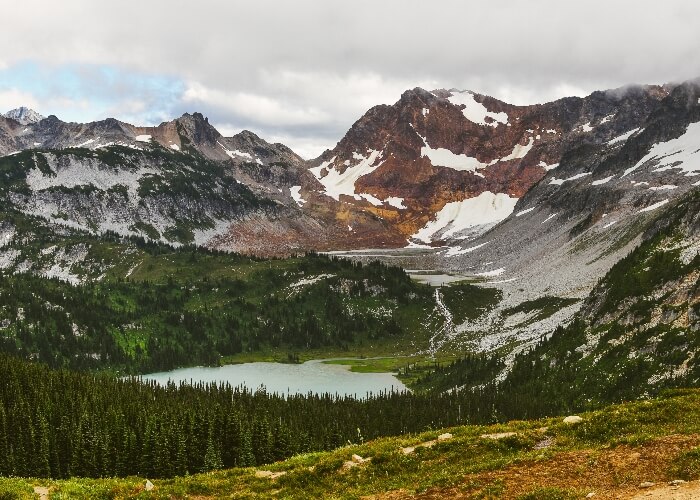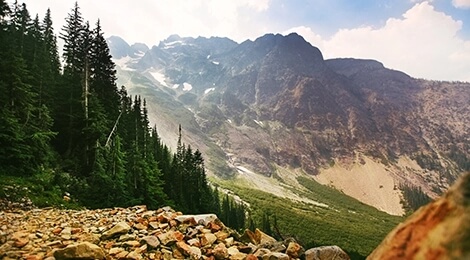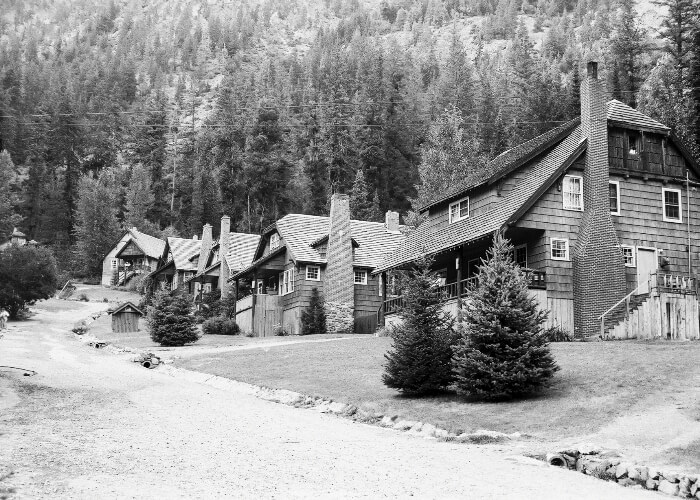Holden was a mining village until the mine closed in 1957. In 1960, Howe Sound Mining Company deeded the Village to the Lutheran Bible Institute in Seattle; programs began in 1962. The disruptions of mine clean-up in 2012-2015, forest fires, and the pandemic have been key events of the last decades. Holden reopened in 2021, and thousands of guests are now returning to the Village, most of whom come in the summer months and stay for about a week.
Holden Village is located in the North Cascade mountains, an area rich in geologic history.
Approximately 400-500 million years ago, rocks that would eventually form the Cascades started forming in the Pacific.
This Valley has existed for millenia, carved out by glaciers and defined by Indigenous people and their care for this place. We live and gather upon the homelands of the Chelan, the Entiat, the P’Squosa, the Wenatchi-Colville and the Wenatchi-Yakama Tribal Nations. And we commit to resisting erasure of Indigenous people and stories, following Native leadership, and centering tribal voices.
On July 24, 1896, a prospector named James Henry Holden noticed a promising outcropping of ore on the side of what is now known as Copper Peak. The challenges—both geographic and financial—of mining in this remote wilderness would delay establishment of a producing mine for another 42 years, 20 years after Holden’s death.
When copper prices fell, Howe Sound closed the mine, listing the townsite for sale for $100,000. Wes Prieb, a 34-year-old purchasing agent with the Army Corps of Engineers in Alaska, read of the sale in a newspaper while waiting for a ride to a church picnic. Persistently, Prieb wrote to the company suggesting the idea of the site as a retreat center.
Part of renewing our relationship with the earth includes addressing the legacy of the pollutants left from Holden’s mining era, 1937-57. The Holden Mine remediation project, mandated under federal law and overseen by the U.S. Forest Service was a half-billion dollar effort aimed at keeping contaminants out of the groundwater and Railroad Creek.
In 2015, the Wolverine Fire forced temporary evacuation of Holden Village. While the Village was saved, the fire burned vast portions of the surrounding forest.
On June 29, 2015, lightning struck three miles northwest of Lucerne (port of Holden Village on Lake Chelan) and started the Wolverine Fire. High temperatures and low humidity provided ideal conditions for the fire to spread.

Holden Village is located in the North Cascade mountains, an area rich in geologic history.
Approximately 400-500 million years ago, rocks that would eventually form the Cascades started forming in the Pacific. In a series of continent fragments or oceanic islands known as “terranes,” they moved northward about 90 million years ago and collided into the North American plate. These terranes formed early mountains that preceded the Cascades, but eventually eroded. Around 37 million years ago, the Cascade volcanoes began to form as the Juan De Fuca plate collided with and subducted beneath the North American plate. As the heavier ocean crust of the Juan De Fuca plate moved beneath the lighter continental crust of the American plate, the friction created intense heat that melted rock. The magma that surfaced formed the Cascade volcanoes.
Holden is located in the Chelan Mountains Terrane. As volcanic magma and ocean water mixed, creating an acidic environment, metals precipitated and a copper iron sulfide mineral (Chalcopyrite) formed. The copper ore that was eventually mined at Holden was exposed through the uplifting of the colliding plates and erosion.
The Cordilleran ice sheets started carving out the Cascades around 2.6 million years ago, with current river valleys in the area carved out about 1.6 million years ago. Three different glaciers carved the Railroad Creek Valley.
Just as Holden Village is an ever-changing community within an ever-transforming ecosystem, the North Cascades continue to rise, form, and shift at a geological timescale.
This Valley has existed for millenia, carved out by glaciers and defined by Indigenous people and their care for this place. We live and gather upon the homelands of the Chelan, the Entiat, the P’Squosa, the Wenatchi-Colville and the Wenatchi-Yakama Tribal Nations. And we commit to resisting erasure of Indigenous people and stories, following Native leadership, and centering tribal voices.
The first inhabitants of this land were the Wenatchee tribe who lived along the Wenatchee River. This river flows from the Cascade Mountains into the Columbia River. They spoke a version of Salish, also called Salishan and Interior Salish. Wahnaachee is the name given the tribe by the Yakama who passed it to explorer Captain William Clark in 1804. Wenatchee is a Sahaptian (Suh-hap-tea-an) word for “water coming out” (Ruby, 266). The people called themselves Pisquoses.
The Chelan tribe lived along the south end of Lake Chelan and the short river that drained the lake to the Columbia. The Chelans would paddle canoes 50 miles to the head of the lake and trek over the mountains to trade with the tribes of Puget Sound.
The culture and economy of the tribes centered around fishing, but the members also gathered roots and berries and hunted game. Winters here are very long and cold with Holden getting over 200” of snow per year so extended families generally spent winters in permanent settlements of mat-covered longhouses and then dispersed from spring to autumn to fish and hunt.
On June 9, 1855, the Wenatchee chief Tecolekun (d. 1858), and 13 other Native American leaders under threat of war, hesitantly signed the Yakima Treaty at the Walla Walla Council with then Governor Isaac Stevens. This treaty extinguished the indigenous people’s title to 10.8 million acres of north central Washington in exchange for a much smaller reservation, cash, and other incentives. While the tribes were deeply upset over the treaty, many leaders felt signing was the only way to prevent further bloodshed. The treaty lumped together the Chelans and Wenatchees as part of the “Consolidated Tribes and Bands of the Yakima Nation,” even though they spoke a language different from that spoken by the Yakimas.
The treaty failed to invoke peace as the native peoples were discontent in having to leave their homelands and with white settlers continuing to stake claim in land that was legally native land. In 1858, war broke out again with many Native Americans losing their lives in the process. It is important to recognize the lives lost of this land’s first stewards when discussing Holden’s history in order to honor our vow of preventing the erasure of indigenous histories. After the war, most Wenatchees and Chelans ended up settling on the Colville Reservation where many still reside today.
In considering the history of Holden Village, it is important to remember that Holden Village is on (sentence from Hello Holden tour). The Village operates with a special use permit from the National Forest Service.

On July 24, 1896, a prospector named James Henry Holden noticed a promising outcropping of ore on the side of what is now known as Copper Peak. The challenges—both geographic and financial—of mining in this remote wilderness would delay establishment of a producing mine for another 42 years, 20 years after Holden’s death. But his name lived on as the Howe Sound Mining Company developed the Holden Mine into Washington state’s largest copper, gold and zinc mine, operating from 1938 to 1957. Village population during the mining era was around 600 people.
When copper prices fell, Howe Sound closed the mine, listing the townsite for sale for $100,000. Wes Prieb, a 34-year-old purchasing agent with the Army Corps of Engineers in Alaska, read of the sale in a newspaper while waiting for a ride to a church picnic. Persistently, Prieb wrote to the company suggesting the idea of the site as a retreat center. The company remained adamant about the asking price until a surprising response to Prieb’s letter of April 1, 1960. Howe Sound had decided to give the Holden property to the Seattle Lutheran Bible
Institute, where Wes was a student. Possibly none were more surprised than LBI leaders, who had been unaware of Prieb’s correspondence.
The school created an interim committee in August 1960 to determine future sponsorship and program. In May 1961, Holden Village was incorporated as a separate, non-profit organization with a mission of lay renewal. That summer, a remarkable group of young adults, called the “Forerunners,” cleaned buildings, repaired vandalism, cut trails, and revived lawns, along with daily Bible study and study of the natural environment. Formal programs began in 1962. The first director, Carroll Hinderlie, was called in 1963 to create, in his words, a “retreat center for training in 20th century discipleship, a quiet place in the land where conversation takes place between persons exposed through the Spirit.”
For more than 60 years, Holden Village continues to transform from a copper mining town to a vibrant place of education, programming, and worship that welcomes all people into the wilderness to form and renew their relationships with God, the earth, and each other.

Part of renewing our relationship with the earth includes addressing the legacy of the pollutants left from Holden’s mining era, 1937-57. The Holden Mine remediation project, mandated under federal law and overseen by the U.S. Forest Service was a half-billion dollar effort aimed at keeping contaminants out of the groundwater and Railroad Creek. With completion of major mine remediation construction in late 2016, Rio Tinto, one of the world’s largest mining groups, is managing and paying for the cleanup and ongoing operation of a new water treatment plant. Water is now purified in a water-treatment plant before being discharged back into the environment. More than 120 acres, primarily across Railroad Creek to the south of Holden Village, were impacted. Massive tailings piles were regraded and planted with thousands of trees. The old mill structure was demolished and Railroad Creek was moved to accommodate a massive, underground barrier wall.
Heavy construction began in 2013 and lasted two years longer than originally anticipated. The remediation era was both a challenge and blessing for Holden Village. The Village was not able to follow its traditional rhythms of welcoming guests but housed and fed up to 250 mine construction workers. At the same time, an absence of guests allowed Holden to pursue its own heavy construction, upgrading infrastructure and facilities that also dated back to the mining era. Power lines were buried, roofs replaced, the hydroelectric system upgraded, a new footbridge replaced over Railroad Creek, and more areas were made ADA accessible. New metal roofs and the industrial sprinkler system that would prove to be vital in protecting the Village from forest fires were also installed during this time.
In 2015, the Wolverine Fire forced temporary evacuation of Holden Village. While the Village was saved, the fire burned vast portions of the surrounding forest.
On June 29, 2015, lightning struck three miles northwest of Lucerne (port of Holden Village on Lake Chelan) and started the Wolverine Fire. High temperatures and low humidity provided ideal conditions for the fire to spread. On July 31, 2015, over 300 people, including Villagers and mine remediation workers, were evacuated from Holden Village, as the fire threatened to block access to the road to Lucerne. A small crew of people stayed behind to look after the Village. This stay behind crew was evacuated on August 2, 2015 as access to the road was compromised by the fire and out of concern for their safety. Before leaving, the crew activated the Rain Bird sprinklers and prepped buildings. Three days later, on August 7, 2015, five Villagers were airlifted back to Holden Village to support firefighters and utilities. Hot shot crews were stationed at Holden Village and used the kitchen and facilities as they worked to clear trees and set backburns to prevent the fire from reaching the Village. The fire continued to spread along the shores of Lake Chelan and on August 15, 2015, downlake properties of Holden Village, including the B&B, were evacuated. Thanks to the hard work of firefighters and the five members of the stay-behind crew, the fire moved around the Village and did not burn any structures. On September 7, 2015, Holden staff were permitted to return. In total, the Wolverine Fire burned 65,323 acres in Central WA. Holden partially reopened to guests in 2016. The changes in the forest ecosystem are visible while traveling up the road to the Village from Lucerne.
On August 15, 2021, a fire was reported near Twentyfive Mile Creek, causing the Holden Village B&B to evacuate and Fields Point Landing to close. Fields Point Landing reopened 12 days later, but the B&B remained closed until the beginning of September.
As climate change continues to create warmer temperatures and shift weather patterns, drying out forests and creating longer and more intense forest fire seasons, stewarding the health of nearby forests remain top of mind for Holden.

Holden Village is in its seventh decade of operation as a retreat center, emerging from the challenges of mine remediation, forest fires, and the pandemic, and looking ahead with a vision to continue expanding welcome to the wilderness. The Portal is a new discovery center, classroom space, and museum that will better tell the stories of this valley, its ecosystems, and its inhabitants. Construction will begin late Summer 2024 or late spring 2025 and exhibits will be installed two years after construction is completed.
Holden Village is a community where your questions are valued and encouraged. Most programs led by visiting teaching faculty occur during the summer months. However, Holden also invites faculty to teach sessions for special events and retreats throughout the rest of the year.
Check out a list of the 2024 Summer Faculty.